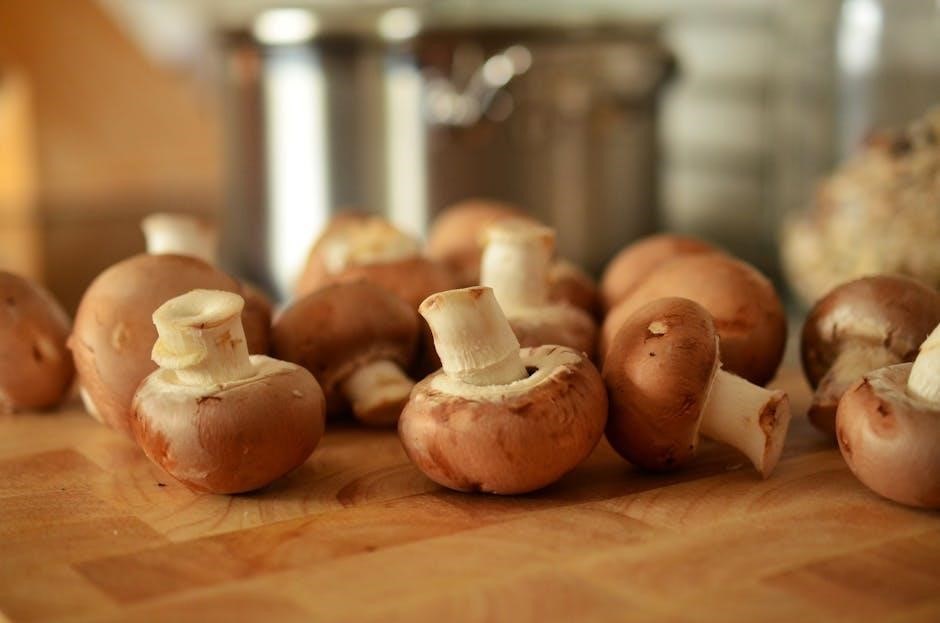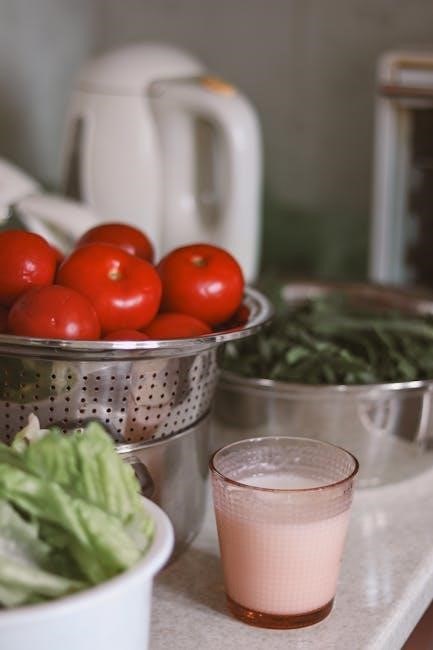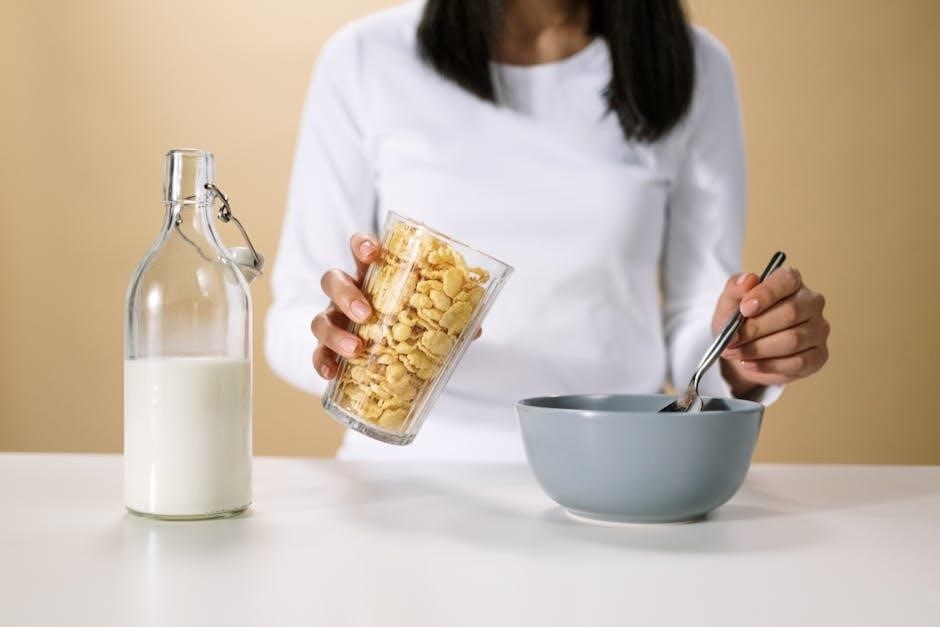
The 21 Day Diet Plan is a structured program combining balanced nutrition and exercise to promote sustainable weight loss and healthy habits. It offers a flexible, 3-week strategy with customizable meal plans and portion control, designed to reset eating patterns and boost metabolism. The plan emphasizes whole, unprocessed foods and regular physical activity, providing a clear roadmap for achieving and maintaining a healthier lifestyle. With a focus on gradual changes, it helps users adopt mindful eating habits and track progress effectively, ensuring long-term success beyond the initial 21 days.
Overview of the Plan
The 21 Day Diet Plan is a well-structured program designed to kickstart weight loss and foster healthy habits. It divides the journey into three distinct weeks: detox, portion control, and maintenance. The plan includes detailed meal plans, daily workouts, and grocery guides to ensure a balanced approach. It emphasizes portion-controlled meals, nutrient-dense foods, and regular hydration. Customizable to suit various dietary preferences, the plan also incorporates tracking tools to monitor progress. By combining nutrition and exercise, it creates a holistic approach to achieving sustainable weight loss and improved overall well-being within 21 days.
Benefits of a 21 Day Diet Plan
Benefits of a 21 Day Diet Plan
A 21 Day Diet Plan offers numerous benefits, including accelerated weight loss, improved metabolism, and reduced sugar cravings. It helps reset eating habits, promoting a balanced intake of nutrients. The structured approach enhances digestion, increases energy levels, and supports overall well-being. By focusing on portion control and mindful eating, it encourages sustainable lifestyle changes. The plan also boosts mental clarity and motivation, making it easier to maintain healthy habits beyond the initial 21 days. It’s an effective way to kickstart a healthier, more disciplined approach to nutrition and fitness.
Setting Realistic Expectations
Setting realistic expectations is crucial for the success of a 21 Day Diet Plan. Aim for gradual weight loss of 1-2 pounds per week, as rapid results are unsustainable. Focus on building healthy habits rather than extreme restrictions. Stay hydrated, track portion sizes, and allow occasional treats to avoid frustration. Celebrate small victories, like improved energy or better digestion, to stay motivated. Remember, this plan is a foundation for long-term change, not a quick fix. Patience and consistency are key to achieving lasting results.

Understanding Caloric Needs
Understanding your daily caloric needs is essential for weight loss. Aim for 1400-1500 calories, track intake, and balance macronutrients to optimize results and maintain energy.
Calculating Daily Caloric Intake
Calculating daily caloric intake involves determining your Basal Metabolic Rate (BMR) and adjusting for activity level. For men: BMR = 66 + (6.2 × weight lbs) + (12.7 × height inches) – (6.8 × age years). For women: BMR = 655 + (4.35 × weight lbs) + (4.7 × height inches) – (4.7 × age years). Multiply your BMR by an activity factor (1.2-1.55) to estimate your Total Daily Energy Expenditure (TDEE). Aim for a caloric deficit of 500 calories per day for weight loss, focusing on balanced meals and mindful tracking to maintain nutrition and energy levels.
Adjusting for Weight Loss
To achieve weight loss, create a caloric deficit by consuming fewer calories than your body burns. Aim for a daily intake of 1400-1500 calories, adjusted based on your activity level and goals. Focus on balanced macronutrients: 40% carbohydrates, 30% protein, and 30% fats. Incorporate portion-controlled meals with lean proteins, whole grains, and fiber-rich vegetables to stay satisfied and support metabolism. Track your intake using containers or a food diary to ensure consistency and make gradual adjustments as needed for sustained progress.
Macronutrient Balance
Achieving macronutrient balance is crucial for sustained energy and metabolism. Aim for a ratio of 40% carbohydrates, 30% protein, and 30% fats. Carbohydrates provide energy, while proteins support muscle repair and growth. Healthy fats aid in nutrient absorption and satisfaction. Focus on whole, unprocessed foods like lean meats, whole grains, and fiber-rich vegetables. This balance ensures metabolic efficiency, prevents cravings, and supports overall health. Tailor portions based on individual needs to maintain energy levels and promote fat loss during the 21-day plan.

Weekly Breakdown
The 21-day plan divides into three phases: detox, portion control, and maintenance. Each week focuses on resetting habits, balancing meals, and forming sustainable routines for long-term success.
Week 1: Detox and Cleanse
Week 1 focuses on resetting your metabolism and reducing sugar cravings. It emphasizes eating fruits, vegetables, lean proteins, and herbal teas to cleanse your body. Avoid processed foods and stay hydrated. This phase helps eliminate toxins, boost energy, and prepare your system for healthier habits. By focusing on nutrient-dense meals and portion control, you’ll set the foundation for sustainable weight loss and improved digestion throughout the plan.
Week 2: Portion Control and Balance
Week 2 introduces portion-controlled meals and balanced nutrition, focusing on macronutrient distribution. Eat lean proteins, whole grains, and healthy fats to maintain energy levels. Use containers or measuring tools to gauge portion sizes, ensuring meals are nutrient-dense but calorie-conscious. This phase helps stabilize metabolism and prevents extreme hunger, promoting sustainable habits. Incorporate a variety of colors on your plate to ensure diverse nutrients. Stay hydrated and avoid processed foods to support your progress from the detox phase into a more structured eating routine.
Week 3: Maintenance and Habit Formation
Week 3 focuses on maintaining progress and forming lasting habits. Emphasize consistent balanced meals, regular hydration, and mindful eating. Incorporate physical activity to sustain energy levels and metabolism. Track your meals and progress to stay accountable. Avoid emotional eating by identifying triggers and choosing healthier alternatives. Celebrate small victories to stay motivated and reinforce positive habits. This phase prepares you for a sustainable lifestyle beyond the 21-day plan, ensuring long-term weight management and overall wellness.

Daily Meal Plan
A structured 21-day diet plan offers balanced nutrition, portion control, and meal tracking. It’s divided into three weeks, with sample meals provided for each day to ensure sustainability and success.
Day 1-7: Sample Meals
Start with simple, nutrient-rich meals. Breakfast options include scrambled egg whites with whole grain toast or Greek yogurt with berries. Lunches feature salads with lean proteins like grilled chicken or fish. Snacks include mixed nuts or fresh fruits. Dinners focus on portion-controlled meals like baked salmon with steamed vegetables or quinoa with roasted lean meats. Drinks include herbal teas or water. These meals provide balanced nutrition, helping you stay on track while adjusting to the plan. Use a printable tracker to monitor progress and ensure portion control.
Day 8-14: Progressive Meals
During days 8-14, meals become more varied while maintaining portion control. Breakfast options include apple cinnamon oatmeal or avocado toast with poached eggs. Lunches feature couscous salads with grilled chicken or plant-based alternatives; Snacks like mixed nuts or yogurt with berries keep energy levels steady. Dinners introduce lean proteins like salmon with celeriac chips or turkey patties with roasted vegetables. These meals balance macronutrients, ensuring sustained energy and gradual weight loss. Adjust portion sizes based on individual needs to maintain progress without feeling deprived.
Day 15-21: Final Push Meals
During the final week, meals focus on nutrient-dense foods to maximize weight loss and energy. Breakfasts include 3 scrambled egg whites, whole grain toast, and optional feta or spinach. Lunches feature lean proteins like grilled chicken or fish with roasted vegetables. Snacks remain light, such as berries or nuts. Dinners emphasize balanced portions of protein and fiber, like salmon with asparagus or turkey patties. Stay hydrated and maintain portion control to push through the last days, ensuring a strong finish to the 21-day plan.

Exercise Plan
The 21 Day Diet Plan includes a structured exercise routine with daily workouts, progressive intensity, and tracking of physical activity to support sustainable weight loss and overall fitness.
Daily Workouts
The 21 Day Diet Plan incorporates daily workouts to support weight loss and overall fitness. Workouts are designed to be manageable and progressive, alternating between cardio and strength training. Activities include brisk walking, bodyweight exercises, and yoga for flexibility. The plan encourages 30-45 minutes of moderate exercise daily, with rest days scheduled to allow muscle recovery. Workouts are tailored to suit all fitness levels, ensuring consistency and gradual intensity increases. This balanced approach helps maintain motivation and promotes sustainable physical activity habits beyond the 21-day period.
Progressive Intensity
The 21 Day Diet Plan includes a progressive intensity workout schedule to maximize results without causing burnout. Workouts start with moderate exercises like brisk walking and bodyweight training, gradually increasing in intensity over the three weeks. Week 1 focuses on building a foundation, Week 2 introduces more challenging routines, and Week 3 pushes for peak effort. This structured approach ensures continuous progress, avoids plateaus, and keeps motivation high, leading to sustainable fitness improvements by the end of the program.
Tracking Physical Activity
Tracking physical activity is crucial for monitoring progress and staying motivated during the 21 Day Diet Plan. Use a fitness journal or mobile app to log daily workouts, including duration, type, and intensity. This helps ensure consistency and accountability. Regularly reviewing your activity levels allows you to adjust routines and celebrate milestones. Incorporate wearable devices to track steps, calories burned, and heart rate for added insights. Consistent tracking keeps you focused and motivated, ensuring you meet your fitness goals within the 21-day timeframe.

Grocery Shopping Guide
A well-planned grocery list is essential for the 21 Day Diet Plan. Focus on whole, unprocessed foods like fruits, vegetables, lean proteins, and whole grains. Plan your shopping trip to include all necessary ingredients for the meal plan, ensuring you have healthy options readily available to stay on track and avoid last-minute unhealthy choices.
Essential Items
Your grocery list should include lean proteins like chicken, fish, and tofu, along with whole grains such as brown rice, quinoa, and whole-grain bread. Stock up on a variety of colorful vegetables like broccoli, spinach, and bell peppers, and fresh fruits like berries, apples, and citrus. Healthy fats such as avocado, nuts, and olive oil are also crucial. Don’t forget low-calorie snacks like Greek yogurt, almonds, and herbal teas to keep you satisfied throughout the day.
Weekly Shopping List
Plan your groceries with lean proteins like chicken, turkey, or tofu, and whole grains such as quinoa, oats, and brown rice. Include a variety of vegetables like spinach, broccoli, and carrots, and fruits such as apples, berries, and oranges. Add healthy fats like avocados, nuts, and seeds. Don’t forget eggs, Greek yogurt, and low-calorie snacks like almonds and herbal teas. For hydration, stock up on water and green tea. Adjust quantities based on your meal plan and personal preferences to ensure freshness and variety throughout the week.
Meal Prep Tips
Plan your meals for the week and shop accordingly to avoid waste. Use reusable containers to portion out breakfast, lunch, and snacks. Chop vegetables and marinate proteins in advance for quick assembly. Cook meals in bulk, such as soups or grains, and refrigerate or freeze for later use. Schedule meal prep days to maintain consistency and save time. Label and date leftovers for easy tracking. Keep healthy snacks visible for easy access. Stay organized with a prep calendar to ensure variety and adherence to your diet plan.

Hydration and Supplements
Drinking 8-10 glasses of water daily supports metabolism and overall health. Consider supplements like multivitamins or probiotics, but consult a healthcare professional before starting any regimen.
Importance of Water
Staying hydrated is crucial for overall health and weight loss. Water aids digestion, boosts metabolism, and enhances physical performance. Aim for 8-10 glasses daily to support detoxification and maintain energy levels. Even mild dehydration can hinder workouts and slow progress. Incorporating herbal teas and water-rich foods like fruits and vegetables can also contribute to hydration goals. Proper hydration ensures your body functions optimally, making it easier to stick to your diet and exercise routine throughout the 21-day plan.
Recommended Supplements
Supplements can enhance your 21-day diet plan by filling nutritional gaps. Multivitamins ensure you meet daily nutrient needs, while fiber supplements support digestion. Probiotics promote gut health, aiding in proper nutrient absorption and metabolism. Additionally, omega-3 fatty acids can reduce inflammation and improve overall well-being. Always consult a healthcare provider before adding supplements to ensure they align with your health goals. These additions complement your diet, helping you maintain energy and focus throughout the program.
Hydration Schedule
Staying hydrated is essential for metabolism and appetite control. Aim to drink at least 8-10 glasses of water daily, starting with a glass upon waking. Incorporate water-rich foods like cucumbers and oranges. Herbal teas and low-sugar drinks can add variety. Avoid sugary beverages to prevent calorie intake. Track your intake with a hydration app or physical markers on your water bottle. Consistent hydration supports digestion, energy levels, and overall well-being, making it a cornerstone of the 21-day diet plan for optimal results.

Tracking Progress
Monitor weight loss, body measurements, and progress photos weekly. Use a journal or app to track meals, workouts, and hydration. Adjust habits as needed for optimal results.
Weight Loss Tracking
Track your weight loss progress by monitoring weekly changes in weight, body fat percentage, and overall measurements. Use a journal or mobile app to log daily meals, workouts, and hydration levels. Regularly take progress photos to visually assess changes. Adjust portion sizes and exercise intensity based on results. Consistency is key; aim to weigh yourself at the same time each week for accurate comparisons. Celebrate small milestones to stay motivated and ensure sustainable results throughout the 21-day journey.
Body Measurements
Track your progress by taking body measurements weekly, focusing on areas like waist, hips, thighs, and arms. Use a flexible tape measure consistently for accurate results. Document these measurements in a journal or app to visualize changes over time. Compare them alongside weight loss and progress photos for a comprehensive view of your transformation. Regular measurements help monitor fat loss and muscle tone, providing motivation to stay committed to your 21-day plan and celebrate non-scale victories along the way.
Progress Photos
Take progress photos weekly to visually track your transformation. Capture images from multiple angles, such as front, side, and back views, in consistent lighting and poses. This helps monitor physical changes, like fat loss and muscle definition, more effectively than weight alone. Compare photos from Day 1 to Day 21 to see improvements in body composition and overall health. Progress photos serve as powerful motivation and a tangible record of your journey, celebrating non-scale victories and boosting confidence.

Mindful Eating
Mindful eating involves savoring meals without distractions, focusing on flavors, and listening to your body’s hunger cues. Eat slowly, avoid screens, and enjoy balanced, portion-controlled meals to foster healthier habits and satisfaction.
Eating Without Distractions
Eating without distractions is a cornerstone of mindful eating. Turn off electronic devices, creating a calm environment to focus on your meal. Avoid multitasking, such as eating while working or watching TV, to fully engage with your food. Savor each bite, paying attention to flavors, textures, and aromas. This practice helps you enjoy meals more thoroughly, recognize hunger cues, and prevent overeating. By eliminating distractions, you foster a healthier relationship with food and enhance digestion, making the 21-Day Diet Plan more effective for sustainable weight loss.
Listening to Your Body
Listening to your body is essential for a successful diet plan. Pay attention to hunger and fullness cues to avoid overeating or undereating. Stop eating when satisfied, not stuffed, and honor cravings in moderation. Recognize emotional triggers and distinguish between physical and emotional hunger. Stay hydrated, as thirst is often mistaken for hunger. By tuning into your body’s signals, you can make intuitive food choices, avoid unnecessary snacking, and maintain a balanced, enjoyable eating experience throughout the 21-Day Diet Plan.
Avoiding Emotional Eating
Avoiding emotional eating is crucial for staying on track with your 21-Day Diet Plan; Identify triggers like stress or boredom and replace eating with healthier habits, such as walking or meditation. Plan meals in advance to reduce impulse decisions and keep healthy snacks handy. Practice mindful eating by savoring each bite and staying present. Stay hydrated, as thirst can masquerade as hunger. By addressing emotional cravings and focusing on nourishment, you can maintain a balanced diet and avoid unnecessary calorie intake. This fosters a healthier relationship with food and supports long-term weight management.

Common Challenges
Common challenges include managing cravings, staying motivated, and overcoming plateaus. Consistency is key to achieving lasting results in your 21-Day Diet Plan journey.
Handling Cravings
Cravings are a common challenge during the 21-Day Diet Plan. Staying hydrated, choosing healthy snacks, and planning meals in advance can help reduce impulsive eating. Identify emotional triggers and practice mindful eating to avoid overindulgence. Incorporate physical activity to distract and reduce cravings, while ensuring balanced nutrition to maintain satisfaction. Tracking progress and staying committed to the plan helps build discipline and overcomes temptation effectively.
Overcoming Plateaus
Plateaus during the 21-Day Diet Plan can be addressed by recalibrating calorie intake, adjusting macronutrient ratios, and increasing physical activity. Incorporate strength training or high-intensity workouts to boost metabolism. Ensure consistent hydration and adequate sleep, as these factors significantly impact progress. Tracking daily meals and portion sizes helps maintain accountability. Stay committed to the plan, and consider slight adjustments to reignite weight loss. Patience and persistence are key to breaking through plateaus and achieving long-term success.
Maintaining Motivation
Maintaining motivation during the 21-Day Diet Plan requires setting realistic goals, tracking progress, and celebrating small achievements. Stay focused on the benefits of the plan, such as increased energy and improved health. Meal prepping and planning can help maintain commitment, while visual reminders like vision boards or motivational quotes can keep you driven. Share your progress with a friend or join a support group for added accountability and encouragement. Consistency and positivity are key to staying motivated throughout the program.
The 21-Day Diet Plan offers a comprehensive approach to weight loss and healthy living. By combining balanced nutrition, regular exercise, and mindful habits, individuals can achieve lasting results. The plan’s structured yet flexible design makes it accessible for various lifestyles, ensuring sustainable progress. Completing the program fosters a stronger connection with your body and mindset, paving the way for continued health and wellness beyond the initial 21 days.
Final Tips for Success
- Stay hydrated by drinking plenty of water throughout the day to support metabolism and digestion.
- Track your progress daily using a journal or app to monitor meals, workouts, and weight loss.
- Plan meals in advance to avoid last-minute unhealthy choices and save time during the week.
- Maintain a positive mindset and celebrate small victories to stay motivated.
- Consult a healthcare professional before starting if you have any medical conditions or concerns.
Encouragement for Continued Progress
Stay committed to your goals and remember, consistency is key. Celebrate small victories along the way to keep motivation high; Surround yourself with a supportive community and focus on how your body and mind transform. Don’t be too hard on yourself during setbacks—learn from them and move forward. Hydration, mindful eating, and regular exercise will keep you on track. Believe in your ability to create lasting change and embrace the healthier, stronger version of yourself emerging each day.
Next Steps Beyond Day 21
Beyond Day 21, focus on maintaining the healthy habits you’ve developed. Gradually reintroduce foods while listening to your body to avoid setbacks. Continue tracking your meals and physical activity to ensure sustained progress. Hydration and supplements remain crucial for overall wellness. Set new, achievable goals to keep motivation high and consider exploring advanced meal plans or exercise routines. Celebrate your success and use it as fuel to continue your journey toward a healthier, more balanced lifestyle.
FAQ
Common questions include calorie intake, portion sizes, and tracking tools. The plan is customizable, and support is available to ensure success and address concerns effectively.
Common Questions
Many users ask about calorie intake, portion sizes, and meal customization. Others inquire about exercise routines and tracking tools. The plan’s flexibility accommodates various dietary preferences, ensuring suitability for different lifestyles. Common concerns include maintaining motivation and overcoming plateaus, which are addressed through structured guidance and support resources. Additionally, questions about hydration, supplements, and meal prep are frequently raised, highlighting the importance of a holistic approach to achieve desired results within the 21-day timeframe.
Addressing Concerns
Individuals often express concerns about the plan’s sustainability and suitability for different lifestyles. Some worry about feeling deprived or struggling with meal prep. Others question the plan’s effectiveness for long-term weight loss. The program addresses these concerns by offering flexible meal options, portion control, and gradual habit formation. It emphasizes balanced nutrition and realistic expectations, ensuring individuals can maintain healthy eating beyond the 21 days. The plan also provides tracking tools to monitor progress and stay motivated, fostering a sustainable approach to weight loss and overall well-being.
Additional Resources
Supplement your journey with downloadable PDF guides, including detailed meal planners and tracking sheets. Websites like 21DayFix.com offer comprehensive resources, while experts provide customizable tips. Social media platforms feature success stories and community support. Consult with nutritionists for personalized advice. Printable templates and mobile apps help monitor progress. Explore e-books and blogs for recipe ideas and motivational content. These tools ensure you stay informed and motivated throughout your 21-day transformation and beyond.